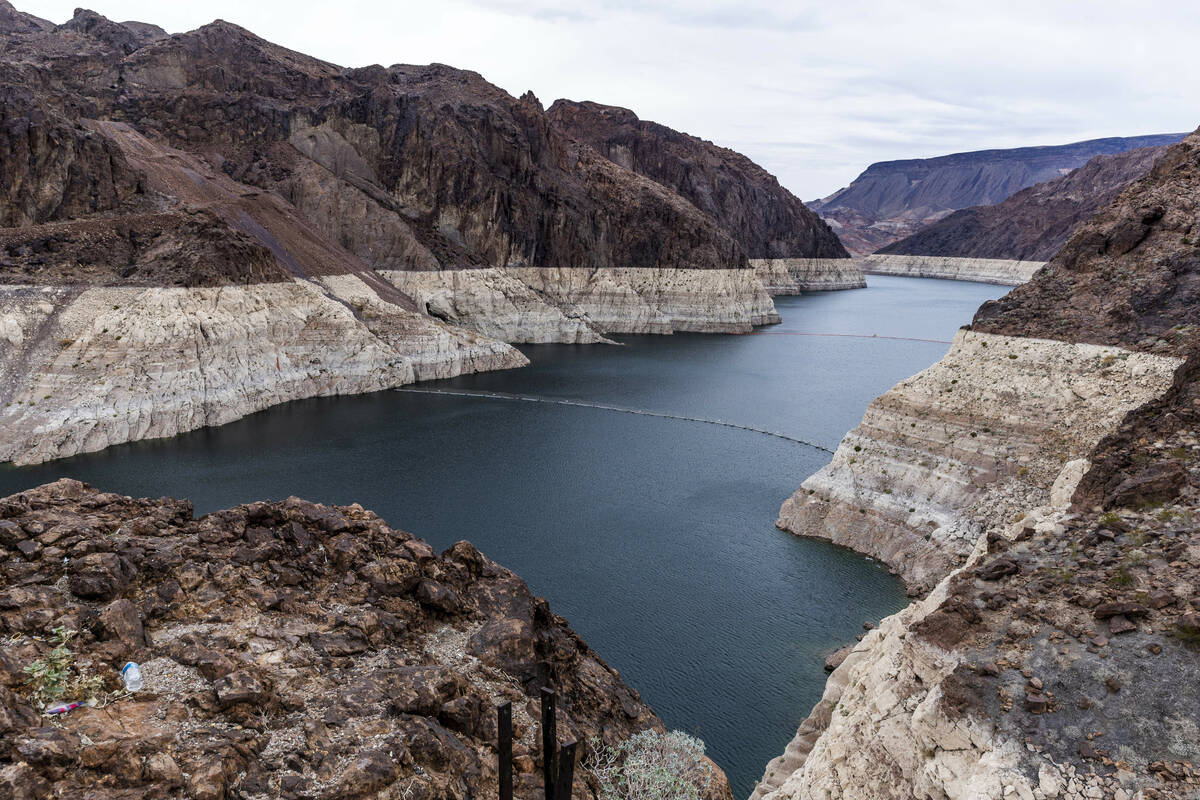Colorado River water managers optimistic about drought plan as deadline looms
Western water managers are optimistic that a deal to buoy the drought-stricken Colorado River can be pieced together in the waning days before a deadline set by the federal government rolls around next week.
The Bureau of Reclamation has given the seven states in the basin until the end of January to propose their own plan for voluntary reductions needed to prevent the river’s two main reservoirs from crashing, or risk the federal government moving forward with its own measures that would most likely result in mandated cuts.
That deadline is just days away, and officials from the states say they are inching closer to an agreement. Those discussions have centered around the only public proposal from any of the states that addresses cuts across the entire basin — one that came from the minds at the Southern Nevada Water Authority and was submitted by the agency as part of the federal government’s review process last month.
There’s no universal buy-in from the states on the water authority’s proposal yet, but water managers in the basin are optimistic that enough common ground can be found for the states to submit a modified version of the Southern Nevada Water Authority’s plan ahead of next week’s deadline, a proposal that at least would give the states an alternative to the two plans the federal government laid out last month.
“We’re definitely closer than we were 40 days ago,” Southern Nevada Water Authority General Manager John Entsminger said this week. And while it may take some tweaks to the proposal in the final days and hours, he said he feels “relatively optimistic” that there will be more than one state endorsing the water authority’s proposal.
In June, Bureau of Reclamation Commissioner Camille Touton told the states they needed to cut overall water use along the river by 2 to 4 million acre-feet of water to prevent Lake Mead and Lake Powell from falling to levels that would threaten hydropower generation and water delivery capabilities along a river that supplies 40 million people across the West, including roughly 90 percent of Southern Nevada’s water.
One deadline came and went without any such agreement between states last fall. In November, the bureau started laying the groundwork to potentially impose mandated cuts across the river basin but gave states another chance to come up with their own proposal for how to implement those reductions.
Only Nevada — which receives the smallest portion the river of the seven basin states at just 1.8 percent of the river’s legal allotment — has put forward a plan that addresses reductions across the entire basin. It’s a proposal that one former Interior Department secretary said should have been put on the table by the federal government at least a year ago.
Cuts coming
The water authority’s plan calls for earlier water delivery cuts to Nevada, Arizona and California, 500,000 acre-feet in cuts for the four states in the upper Colorado River basin, and accounting for more than 1.5 million acre-feet of water lost to evaporation and other losses along the river that would act as reductions in the lower basin, about half of which would come from California’s allocation.
Bruce Babbitt, a former governor of Arizona who served as Interior secretary under former President Bill Clinton, lauded the Southern Nevada Water Authority’s leadership in the latest round of talks at an event in Las Vegas this week.
“It is a comprehensive, careful and detailed plan which now sets the stage for negotiations,” Babbit said. “The underlying genius of that plan and all of its detail is that it says one, we’re together, and secondly, we’re going to share the pain as these incredibly difficult cuts now begin to take place.”
Water managers in other parts of the basin say they see significant promise in the plan from Southern Nevada, but some aspects still give them pause.
Optimistic about agreement
Tom Buschatzke, director of the Arizona Department of Water Resources and the state’s principal negotiator on the Colorado River, said it comes down to how the state deals with some of its higher priority water users such as Arizona’s tribal nations.
“We have to make sure that we can take care of their needs, perhaps some of their culture and religious needs that are tied to some of the water that they use,” Buschatzke said.
Buschatzke said that he is “pretty optimistic” the states can reach an agreement before next week’s deadline — a sentiment shared by one of his counterparts in the upper half of the Colorado River basin.
Chuck Cullom, executive director of the Upper Colorado River Commission, which is made up of representatives from Wyoming, Colorado, Utah and New Mexico, said he expects that the states will reach a consensus for submitting a proposal before the Feb. 1 deadline, but whether every state will be able to endorse the approach remains less clear.
Cullom said the plan includes many concepts that have long been supported by upper basin states, including the accounting for evaporation losses below Hoover Dam. But like Arizona, there are finer details that still need to be ironed out before they would be willing to sign off.
But if there is no consensus agreed to before next week’s deadline, the Southern Nevada Water Authority is prepared to ask for its original proposal to be studied alongside the federal government’s two alternatives, Entsminger said.
“There has to be a third alternative just to be able to compare and contrast some of the choices that this river community has been asked to make. No one’s signing on the dotted line by Jan. 31 saying, ‘Yeah, this is exactly how much cuts we’re going to take. this is exactly how we’re going to operate,’” Entsminger said. “We’re selling 40 million Americans short if we don’t put a third alternative out there.”
Contact Colton Lochhead at clochhead@reviewjournal.com. Follow @ColtonLochhead on Twitter.


















